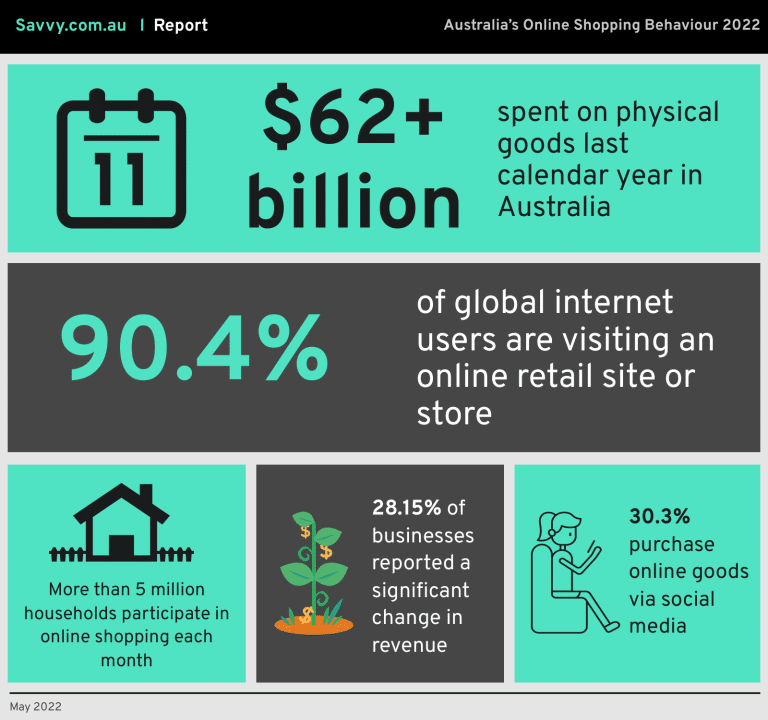
- The Savvy Promise
At Savvy, our mission is to empower you to make informed financial choices. While we maintain stringent editorial standards, this article may include mentions of products offered by our partners. Here’s how we generate income.
In this article
Australia’s online shopping industry is worth over $47 billion dollars. The market size has grown by 8.9% in 2022, proving that more consumers are choosing online shopping over bricks and mortar – and our love affair with retail therapy continues to skyrocket.
- More than 5 million households participate in online shopping each month
- Online retail has increased by over $3 million since January 2020
- In the last calendar year, Australians spent a record $62.3 billion online
- 67% of consumers expect an increase in online delivery speed over the next 12 months
- Almost 30% of Australian e-commerce businesses have reported a significant change in their revenue thanks to online sales
- 90.4% of global internet users visit online retail stores
- 30.3% of Australians have purchased online goods via social media
- A third turned to online shopping over Christmas

How many Australians are shopping online?
Australians are more addicted to retail therapy than ever. Savvy has found since the pandemic, which saw consumers spending further online to stave off boredom, the growth of online retail has been turbocharged as foot traffic becomes web traffic.
While Covid-19 changed the way consumers shop, the post-pandemic shift still indicates online shopping participation will remain strong well into the future.
On average, more than five million households are partaking in online shopping each month. The figure, 5.4 million, is an increase of 39% from 2019. December 2020 recorded 5.68 million households, indicating growth since March which only saw 4.45 million shopping online.
According to recent social media statistics, 90.4% of global internet users are visiting an online retail site or store. 81.5% are searching online for products or services and 76.8% are purchasing a product online.
But significant growth is expected to still come for the Australian market, experts say.
The market size of the online shopping industry has grown 19.6% on average over the last five years between 2017 and 2022.
Compared to the rest of the world though, we are still lagging behind in terms of expenditure and purchase frequency, despite the increase in Australia’s overall online spending. For example, in South Korea, more than half (53%) of online shoppers are buying at least weekly on average, more than double Australia’s figure of 25.3%.
Last year, households in Australia made online purchases at least fortnightly – an increase of 112% from 2019, from 1.6 million to 3.4 million households.
At the beginning of the pandemic, some of the biggest drivers of online shopping were retail restrictions and fear of catching Covid-19. Now, these primary reasons have sharply declined and been replaced by convenience, greater access to products and value for money.
How much money are consumers spending?
In September 2021, Australia had an online retail turnover of over $4 million. This figure is up from the previous year, which recorded a little over $3 million that month.
Non-food retail saw the biggest outlay of $3,250 million, while consumers spent $1,159 million on food.
Throughout the calendar year, Australians spent a record of $62.3 billion on physical goods, from clothing to everyday household items. This means at least four in five households were shopping online bringing the national growth up 12.3% year-over-year.
From a week-by-week perspective, the average person spends $228. Men are the biggest spenders, forking out under $300 compared to $170 for women.
Gen Y is also spending big at $308, while baby boomers are disbursing the least amount ($54). People in New South Wales are splurging more than any other state, with a weekly average spend of $257. On the other hand, West Australians are holding back the most, spending only $164.
Where is the money going?
Homeware and appliances saw the highest expenditure at 23.8%. This was followed by online spending with department stores (16.3%), grocery and liquor (15.3%), personal and recreational (12.4%) and fashion (10.9%).
Consumers spent little on games and toys at 8.9%, with even less expenditure on media (6.4%). Surprisingly, takeaway food had the lowest share of online spending at 5.9%.
There was also an increase in alcohol retail website visits across the country. BoozeBud experienced the highest increase at 94.7%. This was followed by Dan Murphys (39.3%), BWS (35.5%) and Vintage Cellars (24.5%).
Naked Wines were not far behind with a rise of 24.5% in online retail sales, while First Choice Liquor recorded 21.4%.
Purchase frequency is on the rise
Australian households are buying online more often. Compared to 2019, there has been a 73% growth rate on a year-to-year basis.
The downside to this is a lot of retailers have been forced to shut up shop. It does not mean physical stores will completely disappear in the future – consumers still want the luxury to shop wherever and whenever, but shopping centres have certainly felt the pinch of lower foot traffic over the last two years.
Free shipping is the factor most influencing people to buy their groceries online. Over half of Australians (60.93%) say free shipping incentives encourage their shopping habits and provide them with a better overall shopping experience.
Because of this, click and collect has grown to 13.6%. Consumers choose to buy this way because of its immediacy and minimal shipping costs.
Only 16.07% are persuaded to shop for online groceries because of guaranteed fresh fruit and vegetables, while 10.89% agree that delivery within two hours would inspire more online purchases. 4.5% of consumers are encouraged by eco-friendly delivery methods, while 2.62% are driven by online organic food purchases.
What online retail stores are most popular?
Variety stores saw the largest shift in online sales last year at 74.1%. This was closely followed by food and liquor (69.5%) and home and garden (61.2%).
Fashion online retail experienced year-over-year growth of 43.8%, while hobby and recreational goods reported 41.5%. Health and beauty (34.1%) and media (30.1%) had the lowest year-over-year increase.
In terms of online marketplaces, eBay had the most monthly visits by far recording 61.7%. Amazon documented 28.5% visits, while Trade Me (17.7%), Catch.com.au (7.2%) and My Deal (3.5%) fell behind.
What are the top locations?
New South Wales consumers are spending the most, with over 31% taking advantage of the convenience of online retail. Helensburgh in New South Wales is the top suburb by household spending, followed by Silverdale and Seaforth.
Victoria is not far behind at 30%. Point Cook in Victoria’s southwest is the top buying location by purchase volume, followed by Liverpool in New South Wales and Hoppers Crossing in Victoria.
Both New South Wales and the Australian Capital Territory recorded the strongest growth since 2019.
Queensland also benefited from the online shopping craze at 18.1%, while Western Australia (9.1%) and South Australia (6.3%) households were not as active. Tasmania (2.3%), Australian Captial Territory (1.8% ) and Northern Territory (0.7%) all reported less than 5%. Although, Western Australia metro areas and the Northern Territory were above average in growth compared to 2020, according to Australia Post.
On the flip side, Queensland, South Australia, Tasmania, Western Australia regional areas and Victoria all experienced below-average growth. But while Victoria households dropped in their online shopping compared to 2020, the state was above-average growth compared to 2019.
Sustainability is now a consumer expectation
How can online retail shops and parcel collection services improve the environmental sustainability of their operations?
It is a big question for businesses and shoppers, as sustainable practices and packaging become a consumer expectation.
Over eight in 10 Australians now care about environmental sustainability. On top of that, three in four consider some element of sustainability when shopping. As packaging is the first thing people see when they buy online – it is important it uses eco-friendly materials and is practical and purposeful. Otherwise, retailers can easily lose loyal customers.
Consumers are most likely to purchase sustainable products online from grocery retailers, fashion and beauty. 60% are also willing to pay more when it comes to buying ethical and sustainably-made products.
From an online search perspective, sustainable product trends have also increased with more people searching for eco-friendly products. Globally, there has been a 71% rise in the popularity of searches for sustainable goods over the past five years.
As consumers become more conscious, brands should make sustainability core to their businesses to cater for the shift.
Other expectations online retailers believe consumers will want over the next 12 months include an increase in delivery speed (46.67%), customer service (34.07%) and price (25.19%).
Holiday and Lockdown Retail Statistics
Gen Z was the top shoppers intending to buy online for the Black Friday and Cyber Monday sales at 62%. Gen Y followed at 48%, while Gen X (27%) and baby boomers (9%) were significantly lower.
The most popular categories during these sale periods included clothes and shoes (42%), food and alcohol (33%), and electrics and gadgets (25%). Toys followed closely with 24% and beauty, makeup and skincare documented 16%. Only 10% shopped online for travel.
58% of consumers made more purchases last Christmas online compared to the year before. This could be due to the economy slowing bouncing back after a long stint of lockdowns and restrictions previously. The average spend across all age groups was $726.
Throughout lockdowns, click and collect was the most effective customer distribution channel for retailers. Only 13% relied on delivery partners, while 22% did not change their methods.
The pandemic also caused a rise in eBay businesses that started during Covid-19 last year. By income status, 52% use their eBay business as a side hustle while 29% planned to make it their primary job. 11% agreed it become their primary source of income.
"As a company, we have seen an increase in people taking buy now - pay later services when they're applying for finance with us" says Savvy Managing Director Bill Tsouvalas.
"Eventhough it is convenient to use buy now - pay later services, this can pose a financial risk for those who accumulate multiple lines of expensive credit. If you are looking to make a bigger purchase or pay off your debts at a competitive interest rate, a more financially sound option is to apply for a personal loan. This let's you focus on one single repayment with a more competitive interest rate than multiple lines of credit."
The top payment methods
Online payment methods are where businesses are investing their e-commerce capabilities. It makes sense as well, with 75% of consumers using bank cards and e-wallets to make their online purchases. 16% use bank transfers while only 5% are using cash.
Over the past 12 months, PayPal has been crowned the top payment service at 87%. BPAY (61%) and AfterPay (37%) are also popular, with GooglePlay coming in fourth at 21%.
Payment Express (4%) and Stripe (3%) are the least popular services.
61% of consumers have used PayPal and Amazon Pay for their online purchases in the last 12 months. This figure is followed by debit cards (53%), direct debit (50%) and credit cards (43%). 15% pay by invoice, while only 12% are using cash on delivery.
Shop smart and save
Online shoppers want three essentials – convenience, cost savings and product availability.
59% use online discounts or promo codes directly from the retailer, making it a big incentive for businesses to implement and increase customer retention. 32% rely on physical coupons from coupon books or shopping receipts, while 23% use Cashrewards to save.
Wrapping up
These figures present existing possibilities for online retailers to achieve a high level of sales, as well as find new ways to build trust, loyalty and a sense of community with customers. It goes without saying that in 2022, customer retention has never been more essential.
Although this year is predicted to be more stable with slower growth rates than the last two years, the opportunities for retailers are far from over.
In order to remain competitive, retailers should focus on stronger ways to keep their customers engaged and provide them with a better shopping experience through free shipping incentives and instant order status notifications.
Dropbox.com - Online Shopping Behaviour in Australia
Statista.com - Online Shopping Behavior in Australia
Statista.com - Australia Monthly Online Food and Non-Food Total Sales
Statista.com - Australia Online Spending by Category
KPMG - Australian Retail Outlook 2022
SMPerth.com - Social Media Statistics
MirageNews.com - $62.3 billion Boom for E-Commerce as Australian Households Buy up Big
Finder.com.au - Online Shopping Statistics
IPC.be - Cross Border Shopper Survey
Auspost.com.au - E-Commerce Trends - Annual Report
Auspost.com.au - ECommerce Industry Report - 2022
IBISWorld.com - Market Size - Online Shopping
Did you find this page helpful?
Author
Satwik ChavdaGuest Contributor
Bill TsouvalasPublished on May 11th, 2022
Last updated on March 18th, 2024
Fact checked
This guide provides general information and does not consider your individual needs, finances or objectives. We do not make any recommendation or suggestion about which product is best for you based on your specific situation and we do not compare all companies in the market, or all products offered by all companies. It’s always important to consider whether professional financial, legal or taxation advice is appropriate for you before choosing or purchasing a financial product.
The content on our website is produced by experts in the field of finance and reviewed as part of our editorial guidelines. We endeavour to keep all information across our site updated with accurate information.










